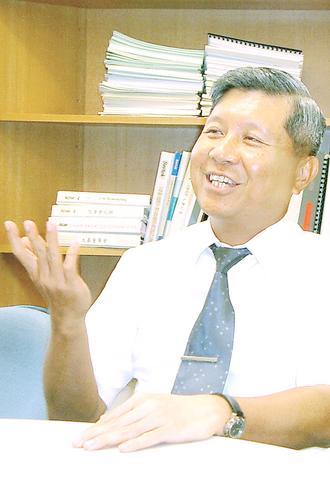Taipei Times: The separation of your brand and manufacturing businesses in 2000 was a crucial and drastic move for Acer. How does that separation help you focus on building your brand business?
Wang Jen-tang (

PHOTO: AMBER CHUNG, TAIPEI TIMES
We now implement the policy of "one company, one brand and one global team" to take charge of our branding with consistency. This has helped us expedite our policy-making process, which is our advantage in the PC industry, where speediness determines victory.
TT: What do you mean to "fully leverage" your manufacturing partners?
Wang: Since quitting manufacturing, we are now exploiting the strength of our manufacturing partners through outsourcing many processes, including manufacturing, distribution networks and industrial design.
For instance, we now cooperate with Quanta Computer Inc (廣達), Wistron Inc (緯創資通) and Compal Electronics Inc (仁寶) in the manufacturing of notebook computers, and with Hon Hai Precision Industry Co (鴻海精密), Micro-Star International Co (微星) and Elite Group Computer System Co (精英電腦) in the production of desktop computers.
We are not only taking advantage of our partners' manufacturing capabilities, but also their distribution networks in prospective markets to help deliver our products to customers.
TT: Many Taiwanese contract manufacturers are shifting to developing brand-name products. Is branding the right direction for Taiwan's information technology industry?
Wang: In my opinion, the branding business is not necessarily better, nor does it necessarily enjoy higher gross margins and profits than original design manufacturing (ODM). They are two different business models.
ODM is a "merchandise business," which is more about technology and products, whereas branding is a "people business," which is more related to thinking and marketing.
Most Taiwanese companies think that a branding business must be linked to its own manufacturing for better growth. But actually they are two different businesses, with different focuses and investments.
Taiwanese ODM companies that would like to expand into the brand-name business for a better return have to separate these two businesses and let branding departments find their own way. There is little likelihood of success if they just want the brand business to help sell more products shipped from their own factories.
TT: Are you suggesting that other ODM makers shouldn't develop their branding strategies like Acer did?
Wang: What I'm saying is that brand positioning, brand promotion and relations with market and distribution partners are the core of a brand-name business, which requires long-term, constant and stable management.
It is very difficult to make consumers remember and accept your brand. They run away as soon as they notice any slack in your efforts to perpetuate the brand. Thus in order to develop the brand into a sustainable one, companies should set up a specialized force, which must have both determination and sufficient resources.
TT: Acer was ranked by International Data Corp as the eighth-largest PC vendor in China, with 1.76 percent of market share last year. With China one of your focus markets this year, how will Acer boost its market power there?
Wang: First, we have made adjustments in our distribution networks in China. In the second half of last year, we replaced the dealerships of four national agents for our laptop products in China with long-term collaborative arrangements, as we found business had fallen off there.
And we gradually adjusted the proxy structure for laptops to 50 agents at provincial or regional levels in March this year. Since this restructuring, we have seen obvious sales growth in April and May.
We also plan to double or triple our marketing expenditures on mass-media advertising, including television advertising twice a year.
But most importantly, we will take advantage of the manufacturing bases and distribution networks of our contracted China-based Taiwanese companies to help deliver our products to customers in a timely manner. Hon Hai, for example, directly distributed the finished products for us to 100 cities through their distribution networks.
To further impress consumers with our brand image and brand value, we launched our new signature design and advanced intuitive user interface [earlier this month]. We believe these efforts and the new business model could help us accomplish the goal of becoming the world's No. 3 PC vendor in the next two to three years.
TT: Havw China's measures initiated in April to cool down the overheating economy impacted Acer's expansion there?
Wang: Almost all PC vendors saw their May sales in China drop by 30 percent, as most people took a wait-and-see attitude that slowed the market. But this crisis could be Acer's great opportunity.
With a sound financial structure, we have been working out how to offer financial support to our Chinese agents and distributors, who may face difficulty in arranging loans from local banks as Beijing tightens credit lines.
The plan can be implemented in August at the soonest. We may offer a total of NT$1 billion to NT$2 billion in credit to our Chinese partners this year. Meanwhile, we would introduce the mechanism of accounts-receivable insurance as a necessary complement in cooperation with European or American insurers who are eager to make inroads into China's markets, such as the leading insurance service company, Marsh Inc.
We expect to strengthen our foothold for sustainable growth with these efforts. We hope to see doubled sales this year in the China market and to squeeze into the top five, while our leading competitors, like Lenovo Group Ltd (
TT: Is Acer looking to expand its business in developing countries like China through increased investment in its desktop business?
Wang: Not exactly. We have been doing well in many regions, not just developing countries. Though the global desktop market has almost stopped growing, we expect our desktop business to grow by 70 percent to 80 percent in the second quarter from a year ago and by 100 percent this year.
Frankly, earnings generated from our notebook computers are sufficient to support our whole operation. We had almost decided to give up the money-losing desktop business before we realizing that the "full leverage" business model could help us expand our business without increasing our costs much.
In Europe, for example, we cooperate with Hon Hai, which had already built up a complete and mature manufacturing base there, and we utilize our existing distribution networks to market desktops. So far, we are the only one in the top 10 vendors that is aggressively tapping the desktop market.
As desktops constitute over 60 percent of the global PC market, our focus on this business will help us grab the No.3 PC vendor position in the future.
TT: Given your determination to re-enter the US market after your withdrawal in 1999, what strategy will Acer use toward this goal?
Wang: We are holding a pragmatic attitude about the US market instead of dreaming of a huge leap in sales there. But both the US and China are essential markets in supporting our sustainable growth in the future.
Based on our successful experience in Europe, we have delegated our European team to take charge of the US strategy, and they will take advantage of their relationships with distributors in Europe to help in our expansion in the US.
Our collaborative distributors in Europe include Tech Data Corp and Ingrant Micro Inc; these are actually leading dealers in their home country, which is the US. They helped our business to double and even triple in Europe, and this collaboration will extend to the US market to fight our common competitors like Dell Inc, which adopted a direct-sales model for mutual benefit.
We also cooperate with our components suppliers, like Intel Corp, ATI Technology Inc and Nvidia Corp, by rolling out new products to tap the market. Our cooperation with sports-car maker Ferrari, whose largest market is the US, will sharpen our edge in publicity.
TT: PC companies have been transforming into consumer electronics and digital home appliance makers in recent years. How will you make Acer stand out from your competitors?
Wang: Digital home appliances are emerging but will not become mainstream in the market for the next two to three years. Shipments of LCD TVs are estimated at about 8 million to 10 million units this year, while the total TV market amounts to 200 million units.
Early birds do not always get the worms. Some brands may even fail while trying to enter such markets in the early stage. So our strategy is to make sure that we will certainly have a share in the sector.
We will focus on current mainstream products and endeavor to strengthen our brand and channels. Then we will enjoy a strong advantage in breaking into the digital home market when it takes off.

Taiwan Semiconductor Manufacturing Co (TSMC, 台積電) last week recorded an increase in the number of shareholders to the highest in almost eight months, despite its share price falling 3.38 percent from the previous week, Taiwan Stock Exchange data released on Saturday showed. As of Friday, TSMC had 1.88 million shareholders, the most since the week of April 25 and an increase of 31,870 from the previous week, the data showed. The number of shareholders jumped despite a drop of NT$50 (US$1.59), or 3.38 percent, in TSMC’s share price from a week earlier to NT$1,430, as investors took profits from their earlier gains

In a high-security Shenzhen laboratory, Chinese scientists have built what Washington has spent years trying to prevent: a prototype of a machine capable of producing the cutting-edge semiconductor chips that power artificial intelligence (AI), smartphones and weapons central to Western military dominance, Reuters has learned. Completed early this year and undergoing testing, the prototype fills nearly an entire factory floor. It was built by a team of former engineers from Dutch semiconductor giant ASML who reverse-engineered the company’s extreme ultraviolet lithography (EUV) machines, according to two people with knowledge of the project. EUV machines sit at the heart of a technological Cold

AI TALENT: No financial details were released about the deal, in which top Groq executives, including its CEO, would join Nvidia to help advance the technology Nvidia Corp has agreed to a licensing deal with artificial intelligence (AI) start-up Groq, furthering its investments in companies connected to the AI boom and gaining the right to add a new type of technology to its products. The world’s largest publicly traded company has paid for the right to use Groq’s technology and is to integrate its chip design into future products. Some of the start-up’s executives are leaving to join Nvidia to help with that effort, the companies said. Groq would continue as an independent company with a new chief executive, it said on Wednesday in a post on its Web

CHINA RIVAL: The chips are positioned to compete with Nvidia’s Hopper and Blackwell products and would enable clusters connecting more than 100,000 chips Moore Threads Technology Co (摩爾線程) introduced a new generation of chips aimed at reducing artificial intelligence (AI) developers’ dependence on Nvidia Corp’s hardware, just weeks after pulling off one of the most successful Chinese initial public offerings (IPOs) in years. “These products will significantly enhance world-class computing speed and capabilities that all developers aspire to,” Moore Threads CEO Zhang Jianzhong (張建中), a former Nvidia executive, said on Saturday at a company event in Beijing. “We hope they can meet the needs of more developers in China so that you no longer need to wait for advanced foreign products.” Chinese chipmakers are in